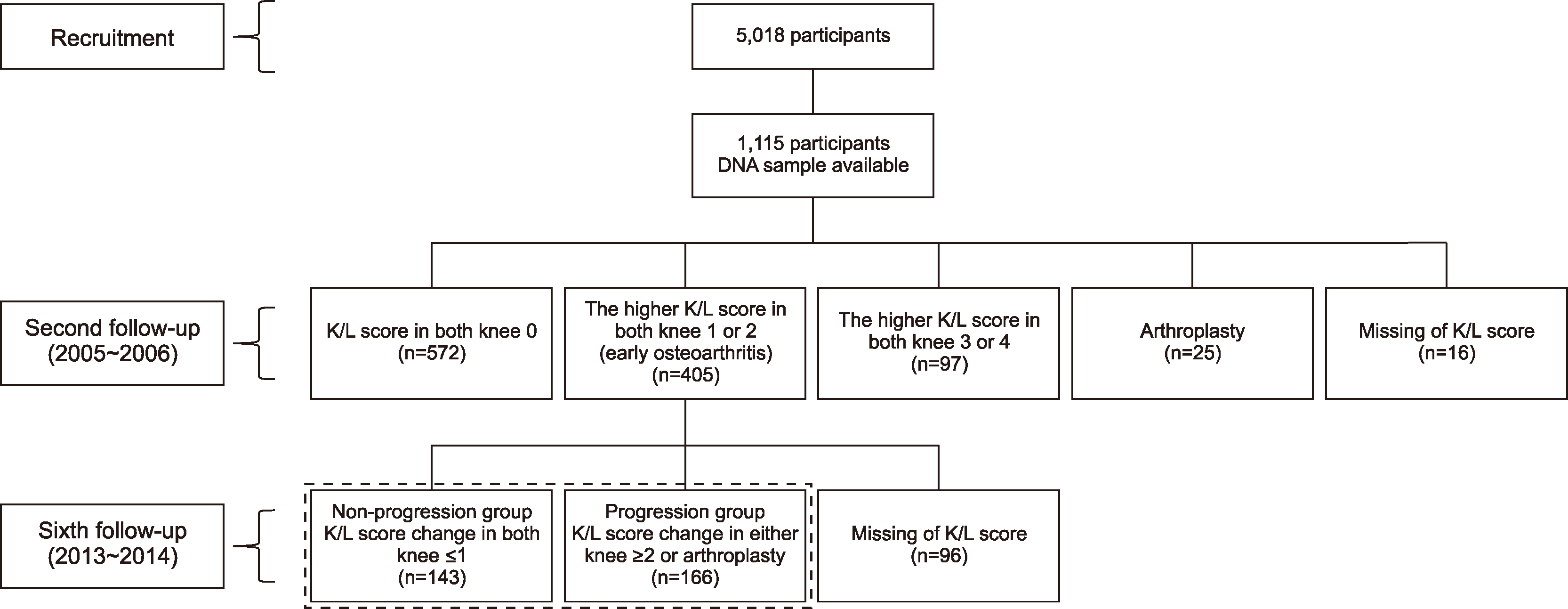1. Blanco FJ, Valdes AM, Rego-Pérez I. 2018; Mitochondrial DNA variation and the pathogenesis of osteoarthritis phenotypes. Nat Rev Rheumatol. 14:327–40. DOI:
10.1038/s41584-018-0001-0. PMID:
29670212.

2. Koo BS, Song Y, Lee S, Sung YK, Shin KJ, Cho NH, et al. 2019; Association of Asian mitochondrial DNA haplogroup B with new development of knee osteoarthritis in Koreans. Int J Rheum Dis. 22:411–6. DOI:
10.1111/1756-185X.13453. PMID:
30549233.

3. Blanco FJ, Rego I, Ruiz-Romero C. 2011; The role of mitochondria in osteoarthritis. Nat Rev Rheumatol. 7:161–9. DOI:
10.1038/nrrheum.2010.213. PMID:
21200395.

4. Fernández-Moreno M, Soto-Hermida A, Vázquez-Mosquera ME, Cortés-Pereira E, Relaño S, Hermida-Gómez T, et al. 2017; Mitochondrial DNA haplogroups influence the risk of incident knee osteoarthritis in OAI and CHECK cohorts. A meta-analysis and functional study. Ann Rheum Dis. 76:1114–22. DOI:
10.1136/annrheumdis-2016-210131. PMID:
27919866.

5. Lotz M, Martel-Pelletier J, Christiansen C, Brandi ML, Bruyère O, Chapurlat R, et al. 2013; Value of biomarkers in osteoarthritis: current status and perspectives. Ann Rheum Dis. 72:1756–63. DOI:
10.1136/annrheumdis-2013-203726. PMID:
23897772. PMCID:
PMC3812859.

6. Minafra L, Bravatà V, Saporito M, Cammarata FP, Forte GI, Caldarella S, et al. 2014; Genetic, clinical and radiographic signs in knee osteoarthritis susceptibility. Arthritis Res Ther. 16:R91. DOI:
10.1186/ar4535. PMID:
24716474. PMCID:
PMC4060235.

7. Rego I, Fernández-Moreno M, Fernández-López C, Gómez-Reino JJ, González A, Arenas J, et al. 2010; Role of European mitochondrial DNA haplogroups in the prevalence of hip osteoarthritis in Galicia, Northern Spain. Ann Rheum Dis. 69:210–3. DOI:
10.1136/ard.2008.105254. PMID:
19224903.

8. Rego-Pérez I, Fernández-Moreno M, Fernández-López C, Arenas J, Blanco FJ. 2008; Mitochondrial DNA haplogroups: role in the prevalence and severity of knee osteoarthritis. Arthritis Rheum. 58:2387–96. DOI:
10.1002/art.23659. PMID:
18668590.

9. Fernández-Moreno M, Soto-Hermida A, Vázquez-Mosquera ME, Cortés-Pereira E, Pértega S, Relaño S, et al. 2017; A replication study and meta-analysis of mitochondrial DNA variants in the radiographic progression of knee osteoarthritis. Rheumatology (Oxford). 56:263–70. DOI:
10.1093/rheumatology/kew394. PMID:
27864563. PMCID:
PMC5854036.

10. Soto-Hermida A, Fernández-Moreno M, Oreiro N, Fernández-López C, Pértega S, Cortés-Pereira E, et al. 2014; Mitochondrial DNA (mtDNA) haplogroups influence the progression of knee osteoarthritis. Data from the Osteoarthritis Initiative (OAI). PLoS One. 9:e112735. DOI:
10.1371/journal.pone.0112735. PMID:
25390621. PMCID:
PMC4229258.

11. Soto-Hermida A, Fernández-Moreno M, Pértega-Díaz S, Oreiro N, Fernández-López C, Blanco FJ, et al. 2015; Mitochondrial DNA haplogroups modulate the radiographic progression of Spanish patients with osteoarthritis. Rheumatol Int. 35:337–44. DOI:
10.1007/s00296-014-3104-1. PMID:
25086630.

12. Cho NH, Kim JY, Kim SS, Shin C. 2013; The relationship of metabolic syndrome and constitutional medicine for the prediction of cardiovascular disease. Diabetes Metab Syndr. 7:226–32. DOI:
10.1016/j.dsx.2013.08.003. PMID:
24290090.

13. Cho NH, Song Y, Lee S, Sung YK, Jun JB. 2018; Incidence of knee chondrocalcinosis and its risk factors in a community-based cohort. Int J Rheum Dis. 21:1391–7. DOI:
10.1111/1756-185X.13317. PMID:
29968327.

14. Lee HY, Yoon JA, Yang WI, Shin KJ. 2013; A one step multiplex PCR assay for rapid screening of East Asian mtDNA haplogroups on forensic samples. Leg Med (Tokyo). 15:50–4. DOI:
10.1016/j.legalmed.2012.08.002. PMID:
22981178.

16. Fang H, Zhang F, Li F, Shi H, Ma L, Du M, et al. 2016; Mitochondrial DNA haplogroups modify the risk of osteoarthritis by altering mitochondrial function and intracellular mitochondrial signals. Biochim Biophys Acta. 1862:829–36. DOI:
10.1016/j.bbadis.2015.12.017. PMID:
26705675.

17. Park S, Cho S, Seo HJ, Lee JH, Kim MY, Lee SD. 2017; Entire mitochondrial DNA sequencing on massively parallel sequencing for the Korean population. J Korean Med Sci. 32:587–92. DOI:
10.3346/jkms.2017.32.4.587. PMID:
28244283. PMCID:
PMC5334155.

18. Liou CW, Chen JB, Tiao MM, Weng SW, Huang TL, Chuang JH, et al. 2012; Mitochondrial DNA coding and control region variants as genetic risk factors for type 2 diabetes. Diabetes. 61:2642–51. DOI:
10.2337/db11-1369. PMID:
22891220. PMCID:
PMC3447893.

19. Jiang W, Li R, Zhang Y, Wang P, Wu T, Lin J, et al. 2017; Mitochondrial DNA mutations associated with type 2 diabetes mellitus in Chinese uyghur population. Sci Rep. 7:16989. DOI:
10.1038/s41598-017-17086-7. PMID:
29208909. PMCID:
PMC5717000.

20. Fuku N, Park KS, Yamada Y, Nishigaki Y, Cho YM, Matsuo H, et al. 2007; Mitochondrial haplogroup N9a confers resistance against type 2 diabetes in Asians. Am J Hum Genet. 80:407–15. DOI:
10.1086/512202. PMID:
17273962. PMCID:
PMC1821119.

21. Williams MF, London DA, Husni EM, Navaneethan S, Kashyap SR. 2016; Type 2 diabetes and osteoarthritis: a systematic review and meta-analysis. J Diabetes Complications. 30:944–50. DOI:
10.1016/j.jdiacomp.2016.02.016. PMID:
27114387.





 PDF
PDF Citation
Citation Print
Print




 XML Download
XML Download